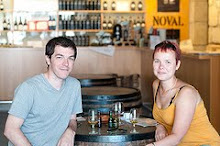After touring central Moscow
Upon arriving we had a quick lunch of grilled shish kabob and an ice cold bottle of Grolsch (a good, light Dutch beer), before heading to Sergiev Posad. We explored the grounds and watched the black-robed priests with awesome (1-2 feet long) beards walking the grounds, often chatting with a devotee or leading a small group of people to a church. Practitioners and pilgrims also surrounded the holy well, splashing their faces, drinking the water or filling bottles to take home. In the single-chamber churches incense filled the air and depictions of Christ, saints and the apostles were painted or embossed on the walls, while gold lanterns hung from the ceiling. It appeared to us to be a deeply personal religion, as the church lacked the pews and “group” lecture approach of western Christianity. Instead, devotees prayed individually at icons, i.e. portraits, of saints that were placed around the chamber, kissing them and lighting candles in supplication. In one church, a group of practitioners stood in the corner singing, but other than that we witnessed very little group activity so common in the west. A beautiful complex, both because of the architecture and the devotion of the people, it is sad to know that during Stalin’s reign in the 1920's, the complex was nearly destroyed. Having murdered or relocated the majority of priests to “work” camps, Stalin kept the complex intact but allowed the army to occupy it and converted the buildings for us of public institutions (including a swimming pool in one hall), and in general wreaked havoc on the once sacred site. It is a testimony to the priests and average Russians to see Sergiev Posad thriving today.
The next day we picked up the Trans-Siberian tickets at our travel agent’s office. Their office also happened to be near one of Moscow's large parks, which doubled as the site of the much delayed (will you believe 4 years because the builders were so behind) All Union Agricultural Fair in the ВДНХ. While picking up our tickets, we chatted with a British bicyclist, who is riding across Eastern Europe, taking the train through Russia to Beijing and then bicycling to Hanoi. Originally one of two, his friend lost his passport on the way (they went back for it and someone had picked it up and ran off) so he is continuing on his own – pretty brave! Meeting fellow travels like that make our day and we’ve managed to stay in touch with quite a few new friends. After a quick lunch of pickled foods (yummy), we arrived at the park, it epitomized the Russian quirkiness that we had been experiencing. Former Soviet statues and monumental buildings dotted the park, while kids played in fountains and costumed park staff sold balloons. Within an hour we had spotted a roller coaster, a Ferris wheel, golf carts, a space shuttle, an air plane (the tail outfitted with a soviet design), arcades, kites, balloons, Soviet-Era statues and a train on wheels. Teenagers lounged around with iPods and kids begged their parents for cotton candy or ice cream to cool off from the heat. It was surreal but very genuine J.
Hot and sweaty, we descended into the Moscow Metro. It is like no other metro in the world with 182 stops. Daily traffic equals over 7 million passengers per day making it the second busiest metro system in the world (following Tokyo, and yes it beat out NYC and London - almost combined even). Built during Communist rule, leaders constructed it as the “peoples’ palace,” with each station’s architecture and artwork unique and impressive. The Metro was also functional, serving as a potential military supply line and nuclear bunker during the Cold War. Top government meetings were often held in stations due to the safety and privacy offered. Each station boasts two “security” staff (usually women) assigned to ensure people on the down escalator stand on the right side and walk / run down on the left side (how cool is that!). Tourists gawk while locals make their way between stops. In general it’s not overly crowded, except at peak times on the main lines (compared to Beijing it was relatively tame).
We noticed that it is common for youth to give their seat to the elderly or infirm and for men to offer to help women carry their oversize bags up the stairs (even happened to Jazz when we were lugging our rolly around). Although watch out if you’re a foreign male – our host was told by one women that she “has a boyfriend already” when he tried to be gentlemanly, so he told her his help was not reliant on her being his girlfriend J. Compared to Hong Kong and even Chicago, there is a decided lack of electronics on the trains, though the younger Russians often had an MP3 player plugged in. This is a very small sample of the Metro artwork; if you’re interested, you can see more photos of the most impressive stations on Flickr or search “Moscow Metro Artwork” in Google.
From the metro we took a boat along the Volga for a different view of the city. A few pictures and a sun tan later, we had a short dinner break at the apartment, our third shower of the day (it was steamy hot outside at nearly 35°C) and set out for night pictures of the Kremlin and St. Basil’s Cathedral. Unfortunately it started raining, so we explored more of the Metro before continuing our night escapades above ground.
 Logging you in...
Logging you in...
